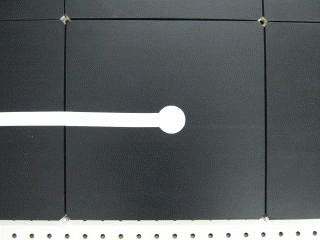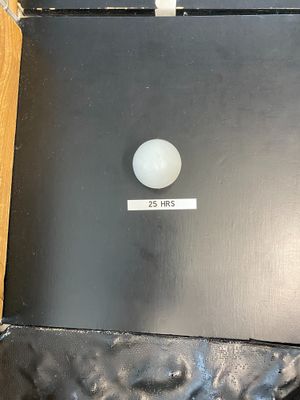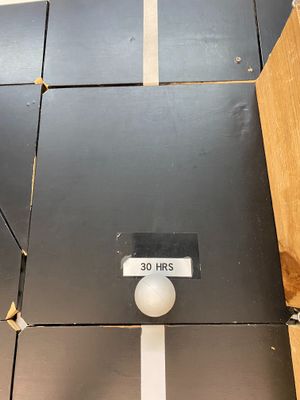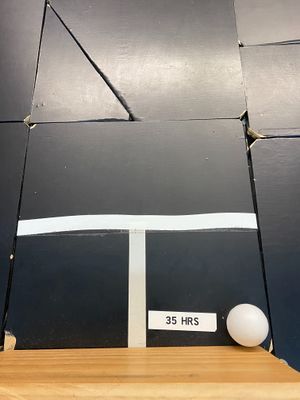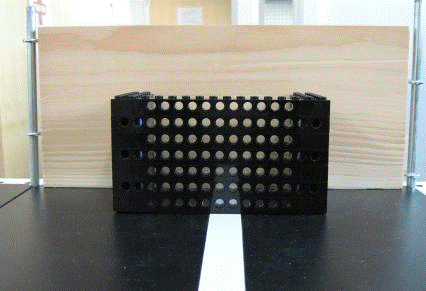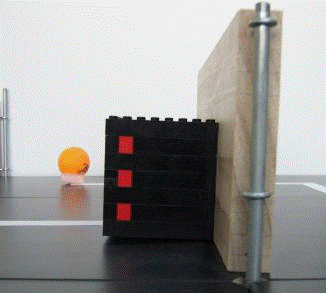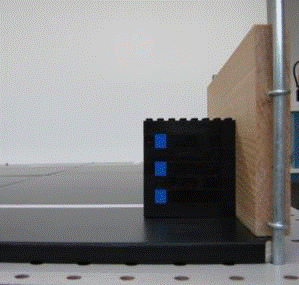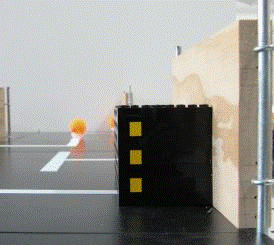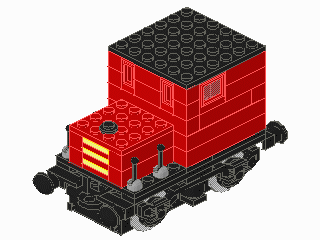Difference between revisions of "Retrieval and Delivery System (RDS)"
(1003 --> 1004) |
|||
| (79 intermediate revisions by 5 users not shown) | |||
| Line 1: | Line 1: | ||
{{SLDP: RFP|Retrieval and Delivery System (RDS)}} | |||
{{SLDP: Real-life Scenarios (Robots)}} | |||
{{SLDP: Outside Materials (Robots)}} | |||
= Introduction and Overview = | |||
A blackout has occurred in the Northeast United States. In the city of New York, three hospitals have used up their backup power supplies due to the unanticipated duration of the blackout. There are some power supply areas in the city with fuel cells that supply enough power for the hospitals' need. In order to save lives, Mayor Bill de Blasio has issued an RFP for a robot that can retrieve and deliver fuel cells accumulating a minimum of 200 hours of reserve energy. | |||
[[Image:RDS_Course1-1-.jpg|500px|thumb|center||Figure 1: New York City navigation field view 1.]] | |||
[[Image:RDS_Course2.jpg|640px|thumb|center||Figure 2: New York City navigation field view 2.]] | |||
= Specifications = | |||
model of your design using the materials provided. A Mindstorms program that will | Design a robot using Lego Digital Designer as your primary design tool. Your team must build a model of your design using the materials provided. A Mindstorms program that will direct the robot's movements must be created. A cost estimate of the robot's components must be provided. All revisions to the original design must be recorded and explained. This includes technical design drawings, as well as cost estimates. All revisions to the Mindstorms program must be recorded and explained. | ||
direct the robot's movements must be created. A cost estimate of the robot's | |||
components must be provided. All revisions to the original design must be | |||
recorded and explained. This includes technical design drawings, as well as cost | |||
estimates. All revisions to the Mindstorms program must be | |||
recorded and explained. | |||
The RDS must be able to navigate autonomously around the city, retrieve fuel cells, and deliver them to the hospitals. <b>Note that these hospital positions may change each semester.</b> The robot must accumulate a total of 200 hours of reserve energy in less than five minutes. The robot's footprint (length and width) may not exceed 12 in × 12 in. | |||
accumulate a total of | |||
(length and width) may not | |||
The robot program may not be altered or switched during any part of the mission. Likewise, the robot must be fully autonomous, and therefore cannot be touched by any person during testing. These specifications <b>must</b> be met for final Commissioning. Please refer to the course syllabus for all due dates. | |||
== Course Layout == | |||
< | <span style="color: red;">'''Note: The pictures below contain one representation of this project description. The actual course may be different from the one pictured below, but similar in objective.'''</span> | ||
Your robot starts on a tile similar to the one in Figure 3. The back of the robot must be facing the side of the tile that is on the outside border of the course: | |||
[[Image:MRDS2.gif|frame|center|Figure 3: Starting tile.]] | |||
Each power supply area has fuel cells that supply different amounts of hours. | |||
[[Image:MRDS3.gif|frame|center|Figure 4: Example of a fuel cell.]] | |||
For example, power supply areas located in the middle of a tile have fuel cells that can supply 25 hours of battery life, as observed in Figure 5. | |||
[[Image:25.jpg|thumb|300px|frame|center|Figure 5: Location of 25-hour fuel cell on tile.]] | |||
Power supply areas located on the edges of a tile have fuel cells that can supply 30 hours of battery life, as observed in Figure 6. | |||
[[Image:30(2).jpg|thumb|300px|frame|center|Figure 6: Location of 30-hour fuel cell on tile.]] | |||
Power supply areas located at the corners of a tile have fuel cells that can supply 35 hours of battery life, as observed in Figure 7. | |||
[[Image:35(2).jpg|thumb|300px|frame|center|Figure 7: Location of 35-hour fuel cell on tile.]] | |||
Each hospital has different efficiencies of energy consumption. | |||
[[Image:MRDS7.gif|frame|center|Figure 8: Example of a hospital.]] | |||
The colors of the sides of each hospital show the power efficiency of the hospital. Billy's Hospital, color-coded in red, uses the energy three times as efficiently as the standard hospital, thereby extending the battery life of a fuel cell to three times its standard battery life. | |||
the | |||
to | |||
[[Image:MRDS8.gif|frame|center|Figure 9: Billy's Hospital (3× efficiency).]] | |||
[[ | |||
Jamie's Hospital, color-coded in blue, uses the energy twice as efficiently as the standard hospital, thereby extending the battery life of a fuel cell to twice its standard battery life. | |||
[[Image:MRDS9.gif|frame|center|Figure 10: Jamie's Hospital (2× efficiency).]] | |||
Luke's Hospital, color-coded in yellow, represents the standard hospital, and therefore fuel cells used at this hospital will retain its standard battery life. | |||
[[Image:MRDS10.gif|frame|center|Figure 11: Luke's Hospital (1× efficiency).]] | |||
< | == Hour Totals == | ||
By successfully returning the retrieved fuel cells to one of the <span style="color: red;">hospitals</span>, the <span style="color: blue;">fuel cell</span>'s battery life is multiplied by the hospital's efficiency. For example, if the robot retrieved a <span style="color: blue;">25-hour fuel cell</span> and successfully placed it in <span style="color: red;">Billy's Hospital</span>, the robot would successfully receive 75 hours for that fuel cell (<span style="color: blue;">25</span> × <span style="color: red;">3</span> = <span style="color: fuchsia;">75</span>). Luke's Hospital is assigned an efficiency of <span style="color: red;">1</span>, Jamie's Hospital is assigned an efficiency of <span style="color: red;">2</span>, and Billy's hospital is assigned an efficiency of <span style="color: red;">3</span>. | |||
{{SLDP: Microsoft Project}} | |||
{{SLDP: Drawings (Robots)|11}} | |||
[[Image:Modular6.gif|frame|center|Figure 12: Sample isometric drawing from LEGO Digital Designer.]] | |||
== Model == | |||
You must build a scale model (1:1) of your design. The following materials will be provided: | |||
# Mindstorms kit | |||
# One EV3 brick | |||
# Sensors | |||
# Motors | |||
The finished RDS must not exceed a footprint of 12 in × 12 in. There is no height limitation. Additional materials can be supplied by your TA. | |||
{{SLDP: Cost Estimate (Robots)}} | |||
< | == Extra Credit == | ||
For <b>each additional</b> fuel cell collected after achieving the 200-hour goal needed for Commissioning, your team will receive extra credit. For example, if your team delivers two 35-hour fuel cells to Billy's Hospital, you would receive four points of extra credit (two points per additional fuel cell) to your final SLDP grade. You can also receive extra credit for completing Benchmark A, Benchmark B, or Submission early, or completing your respective SLDP's 3D printing extra credit task as described in the [https://manual.eg.poly.edu/index.php/Prototyping_Guide Prototyping Guide]. Refer to the [https://manual.eg.poly.edu/index.php/EG_Grading_Policy EG1004 Grading Policy] for exact point values. Creativity and innovation are always rewarded. Original designs will receive extra credit. | |||
{{SLDP: Milestones and Benchmarks}} | |||
{{SLDP: Milestone 1 (Robots)}} | |||
{{SLDP: Benchmark A}} | |||
[ | * Deliver at least 50 hours of reserve energy to local hospitals | ||
* Submission of mandatory 3D print: This includes the submission of either a logo design or extra credit print in the 3D Printing Submission portal on the EG1004 website | |||
**More details about this can be found in the [https://manual.eg.poly.edu/index.php/Prototyping_Guide Prototyping Guide] | |||
* Submission of updated notebook/project journal on the EG1004 website | |||
{{SLDP: Milestone 2 (Robots)}} | |||
{{SLDP: Benchmark B}} | |||
* Deliver at least 125 hours of reserve energy to local hospitals | |||
* Approval of mandatory 3D print: This includes receiving approval of either a logo design or extra credit print by a Protolab TA in the EG1004 Protolab, and showing your Proof of Approval form to a TA | |||
* Submission of updated notebook/project journal on the EG1004 website | |||
{{SLDP: Milestone 3 (Robots)}} | |||
{{SLDP: Commissioning}} | |||
* Deliver at least 200 hours of reserve energy to local hospitals | |||
* Printed mandatory 3D print | |||
{{SLDP: Final Presentation}} | |||
* Problem statement | |||
* Solution overview | |||
* Company description and qualifications | |||
* Drawings | |||
* Mindstorms program | |||
* Cost estimate | |||
* Microsoft Project schedule | |||
* Video demonstration | |||
* Why should the company be awarded this contract? | |||
{{SLDP: Submission}} | |||
** Final presentation | |||
** Final Mindstorms program | |||
** Initial sketch | |||
** All the drawings of your design (initial through final) | |||
** Video | |||
** Final Microsoft Project Schedule | |||
** Final cost estimate | |||
** Resume(s) (no fictitious resumes will be accepted) | |||
** Final notebook/project journal | |||
{{SLDP: Early Acceptance}} | |||
{{SLDP: Late Delivery}} | |||
= Frequently Asked Questions = | |||
Q: Is our robot allowed to fire projectiles on this course? | |||
A: Yes. | |||
Q: If our robot is able to, can we open the one-way door from the other side? | |||
the | |||
A: Yes. | |||
Q: Does the robot have to push the gate? | |||
A: Yes. The gate cannot be opened manually. | |||
Q: Our robot completed the course with over 200 hours, do we get extra credit right away? | |||
A: No. If your robot drops in the final needed fuel cell and your total hours exceed 200 hours, you will not receive extra credit. To get extra credit, you must pick-up and drop-off extra fuel cells after already achieving 200 hours. Additionally, you will only receive extra points corresponding to the number of additional fuel cells you drop-off, not according to the number of additional reserve hours you collect. | |||
Q: We are not picking-up every single fuel cell, so before we start our run, may we move the ping pong balls that we are not planning to pick-up out of the way? | |||
A: No, every ping pong ball must be unmoved from its respective mount at the beginning of each and every trial. | |||
the | |||
{{Semester-Long Design Project}} | |||
Latest revision as of 02:26, 31 August 2022
Request for Proposal: Retrieval and Delivery System (RDS)
This project reflects real life scenarios; the robot must be able to handle minor imperfections in the course.
Note: You should only use the materials contained in the price list for LEGO parts for robot projects. If you want to use other parts, get permission from your faculty member to do so, and also to determine the cost of the parts you want to use that are not in this price list.
Introduction and Overview
A blackout has occurred in the Northeast United States. In the city of New York, three hospitals have used up their backup power supplies due to the unanticipated duration of the blackout. There are some power supply areas in the city with fuel cells that supply enough power for the hospitals' need. In order to save lives, Mayor Bill de Blasio has issued an RFP for a robot that can retrieve and deliver fuel cells accumulating a minimum of 200 hours of reserve energy.
Specifications
Design a robot using Lego Digital Designer as your primary design tool. Your team must build a model of your design using the materials provided. A Mindstorms program that will direct the robot's movements must be created. A cost estimate of the robot's components must be provided. All revisions to the original design must be recorded and explained. This includes technical design drawings, as well as cost estimates. All revisions to the Mindstorms program must be recorded and explained.
The RDS must be able to navigate autonomously around the city, retrieve fuel cells, and deliver them to the hospitals. Note that these hospital positions may change each semester. The robot must accumulate a total of 200 hours of reserve energy in less than five minutes. The robot's footprint (length and width) may not exceed 12 in × 12 in.
The robot program may not be altered or switched during any part of the mission. Likewise, the robot must be fully autonomous, and therefore cannot be touched by any person during testing. These specifications must be met for final Commissioning. Please refer to the course syllabus for all due dates.
Course Layout
Note: The pictures below contain one representation of this project description. The actual course may be different from the one pictured below, but similar in objective.
Your robot starts on a tile similar to the one in Figure 3. The back of the robot must be facing the side of the tile that is on the outside border of the course:
Each power supply area has fuel cells that supply different amounts of hours.
For example, power supply areas located in the middle of a tile have fuel cells that can supply 25 hours of battery life, as observed in Figure 5.
Power supply areas located on the edges of a tile have fuel cells that can supply 30 hours of battery life, as observed in Figure 6.
Power supply areas located at the corners of a tile have fuel cells that can supply 35 hours of battery life, as observed in Figure 7.
Each hospital has different efficiencies of energy consumption.
The colors of the sides of each hospital show the power efficiency of the hospital. Billy's Hospital, color-coded in red, uses the energy three times as efficiently as the standard hospital, thereby extending the battery life of a fuel cell to three times its standard battery life.
Jamie's Hospital, color-coded in blue, uses the energy twice as efficiently as the standard hospital, thereby extending the battery life of a fuel cell to twice its standard battery life.
Luke's Hospital, color-coded in yellow, represents the standard hospital, and therefore fuel cells used at this hospital will retain its standard battery life.
Hour Totals
By successfully returning the retrieved fuel cells to one of the hospitals, the fuel cell's battery life is multiplied by the hospital's efficiency. For example, if the robot retrieved a 25-hour fuel cell and successfully placed it in Billy's Hospital, the robot would successfully receive 75 hours for that fuel cell (25 × 3 = 75). Luke's Hospital is assigned an efficiency of 1, Jamie's Hospital is assigned an efficiency of 2, and Billy's hospital is assigned an efficiency of 3.
Project Schedule
A project schedule must be created in Google Sheets. Please refer to the template provided in your team Google Drive folder and our guide.
This schedule must include all tasks related to the project from the start of the project to Early or Final submission. The project schedule should include:
- Minimum of 20 tasks, excluding Milestones
- Milestones should be clearly indicated on the project plan (duration of zero days)
- Each task must include the person responsible for completing the task (resource names)
- Gantt chart must be displayed alongside the tasks list (fit onto one slide)
- Gantt chart must show a progress line
- Clearly state during the presentations whether the project is on-time, behind schedule, or ahead of schedule
- In milestone presentations, please present a “Project Status” slide, which should summarize key deadlines. You are not required to show your project schedule in these presentations
Drawings
All drawings and sketches should be made using LEGO Digital Designer (LDD). LDD can be installed for free from the LEGO website.
Using LDD, create four drawings of the robot: front, top, most detailed side, and a drawing of the gear train(s). Sensors, motors, and gears must be included in each drawing. If the robot does not use any gears, make sure to explicitly state that in your presentations.
Each revision of the design must be documented and all changes must be presented during Milestone presentations.
Model
You must build a scale model (1:1) of your design. The following materials will be provided:
- Mindstorms kit
- One EV3 brick
- Sensors
- Motors
The finished RDS must not exceed a footprint of 12 in × 12 in. There is no height limitation. Additional materials can be supplied by your TA.
Cost Estimate
Once a robot design is complete, a cost estimate must be generated that specifies the cost of all the materials and labor required for the construction of the design. Tabulate this cost information clearly in an Excel spreadsheet, using the materials cost list provided. Help in calculating the cost is available by reviewing how to plan the schedule and calculate costs for a project. The costs for the parts can be found on the price list for LEGO parts for robot projects.
Note: You should only use the materials contained in the price list for LEGO parts for robot projects. If you want to use other parts, get permission from your faculty member to do so, and also to determine the cost of the parts you want to use that are not in this price list.
The cost estimate should include the following:
- Labor cost breakdown with hours and rates
- Consolidate low-cost pieces: axles, beams, bricks, bushings, connectors, gears, plates
- Itemize high-cost pieces: controllers (EV3 brick), sensors, motors
- No decimal places; this is an estimate after all. Round appropriately
- Total cost must be shown in the bottom right corner
Notebook/Project Journal
While working on your project, you are expected to keep a record of all work done, as well as future plans and goals. In order to complete a Benchmark assessment, you must submit your notebook in .pdf format to the EG1004 website, as well as show your notebook to the Open Lab TA completing your assessment. A guide to writing the notebook, as well as a basic overview of its expectations, can be found here.
Extra Credit
For each additional fuel cell collected after achieving the 200-hour goal needed for Commissioning, your team will receive extra credit. For example, if your team delivers two 35-hour fuel cells to Billy's Hospital, you would receive four points of extra credit (two points per additional fuel cell) to your final SLDP grade. You can also receive extra credit for completing Benchmark A, Benchmark B, or Submission early, or completing your respective SLDP's 3D printing extra credit task as described in the Prototyping Guide. Refer to the EG1004 Grading Policy for exact point values. Creativity and innovation are always rewarded. Original designs will receive extra credit.
Milestones, Benchmarks, and Deliverables
As work is done on the project, three Milestone presentations will report on the project's progress. All of the items assigned in each phase of the project are called Benchmark deliverables. These deliverables often consist of a combination of written submissions, presentations, and demonstrations. Benchmark assessments evaluate the progress of the project.
Preliminary Design Investigation
The Preliminary Design Investigation (PDI) is extremely important, as it lays the groundwork for the project. It outlines the project idea, inspiration, and goals.
The PDI must include:
- Cover Page
- Project Overview
- Goals & Objectives
- Design & Approach
- Cost Estimate
- Project Schedule
- Relevant Pictures
An example PDI template can be found here. The PDI is due by Benchmark A. Do not forget to include the items listed above. Use this link to access the VEX PDI Rubric.
Milestone 1
See How To Give a Milestone Presentation for the format of a Milestone presentation.
Milestone 1 is a presentation of the PDI. It is important that it outlines the project goals and show that the project is realizable.
The Milestone 1 presentation must include:
- Company profile
- Company name
- Product name
- Company officer title(s)
- Mission statement
- Project objective
- What is the project about?
- What tasks is the company aiming to accomplish? (Benchmark A requirements)
- Overall design approach to complete objective
- Background information
- Why is the project happening?
- What does the audience need to know?
- Technical design description
- Preliminary conceptual drawing of robot design
- Rendered and digital sketches are acceptable, CAD not required
- What components will be used and why?
- Preliminary conceptual drawing of robot design
- Cost estimate
- Major components of design listed
- Miscellaneous category listed
- Projected labor listed
- Microsoft Project schedule
- Click here to access the guide on how to transfer a file
- Teamwork agreement summary
- Summary
- Overall assessment on current state of project
- Is the project on schedule? Is it on budget?
- Next steps and future tasks
Look Ahead: What tasks are planned between now and Milestone 2?
Benchmark Assessment A
Benchmarks evaluate the progress of the project. Benchmark A is due at the end of Model Shop Session II. There are penalties for not completing this on time. Refer to the EG1004 Grading Policy for more information.
To pass Benchmark A, the design must complete all of the following:
- Deliver at least 50 hours of reserve energy to local hospitals
- Submission of mandatory 3D print: This includes the submission of either a logo design or extra credit print in the 3D Printing Submission portal on the EG1004 website
- More details about this can be found in the Prototyping Guide
- Submission of updated notebook/project journal on the EG1004 website
Milestone 2
See How To Give a Milestone Presentation for the format of a Milestone presentation.
Milestone 2 Deliverables:
- Presentation:
- Project description
- Design approach
- Design changes since Milestone 1
- Mission statement
- CAD drawings: top, front, most detailed side, isometric, gear train
- Mindstorms program
- Updated cost estimate (previous and current). What changes were made?
- Updated Microsoft Project schedule (previous and current). What changes were made?
- Progress update: current state of the project (time, budget, etc.)
Look Ahead: What tasks are planned between now and Milestone 3?
Benchmark Assessment B
Benchmark Assessment B is due at the end of Model Shop Session III. There are penalties for not completing this on time. Refer to the EG1004 Grading Policy for more information.
To pass, complete all of the following tasks:
- Deliver at least 125 hours of reserve energy to local hospitals
- Approval of mandatory 3D print: This includes receiving approval of either a logo design or extra credit print by a Protolab TA in the EG1004 Protolab, and showing your Proof of Approval form to a TA
- Submission of updated notebook/project journal on the EG1004 website
Milestone 3
See How To Give a Milestone Presentation for the format of a Milestone presentation.
Milestone 3 Deliverables:
- Presentation:
- Project description
- Design approach
- Design changes since Milestone 2
- Mission statement
- CAD drawings: top, front, most detailed side, isometric, gear train
- Mindstorms program
- Updated cost estimate (previous and current). What changes were made?
- Updated Microsoft Project schedule (previous and current). What changes were made?
- Progress update: current state of the project (time, budget, etc.)
Look ahead: What tasks are planned between now and the completion of the project?
Commissioning
Projects must be commissioned before Submission. Refer to the syllabus for Submission deadlines. There are penalties for not completing this on time. Refer to the EG1004 Grading Policy for more information.
To pass, the design must complete all of the following:
- Deliver at least 200 hours of reserve energy to local hospitals
- Printed mandatory 3D print
Final Presentation
The Final Presentation will be a technical briefing, similar to the Milestones, but also serves as a sales presentation explaining why your company should be selected instead of the competition.
Your Final Presentation must include:
- Company profile
- Company name
- Employee profile, role(s), and qualifications
- Mission statement
- Problem statement
- Why is the project happening?
- What does the audience need to know?
- Project objective
- What is the purpose of your project?
- Who does your project help?
- What problem does your project solve?
- Project description
- Specify LEED certification
- Examples of LEED implementations in Revit
- Revit drawings
- All floor plan drawings
- Dimensions
- 1:240 scale
- Views of exterior of building: front elevation, side elevation, isometric elevation
- Dimensions
- Specify LEED certification
- Market and product viability
- Does your company have competitors?
- What makes your project unique?
- How does your design compare to competitors - cost, quality, features?
- Is the project versatile?
- What is the price of your project?
- Conclusion
- Reiterating project purpose
- Highlight project features
- Future goals of the company
- Why should your company be awarded this contract?
- Video pitch
- Price of project
- Walkthrough animation of building in Revit
- Embedded into Final Presentation
- Problem statement
- Solution overview
- Company description and qualifications
- Drawings
- Mindstorms program
- Cost estimate
- Microsoft Project schedule
- Video demonstration
- Why should the company be awarded this contract?
Submission
All SLDPs must be submitted online. Please visit this page for the link to the Project Submission form and each project’s individualized login information. To submit, login to the EG1004 website using this special login information. Submitting with an NYU account or any other account will generate an error. Components may be resubmitted at any time before the deadline. Please note that submission times are based on the most recent submission.
Please note the deliverables for this project are as follows. If any of the following items are omitted, there will be a penalty. Be sure to click "Submit" at the bottom of the form and allow sufficient time for uploading. The following list includes deliverable items that are required:
- Submission deliverables:
- Final presentation
- Final Mindstorms program
- Initial sketch
- All the drawings of your design (initial through final)
- Video
- Final Microsoft Project Schedule
- Final cost estimate
- Resume(s) (no fictitious resumes will be accepted)
- Final notebook/project journal
Late Submission
Late submission is not allowed. If a project does not Commission or receive Partial Commission by the deadline set forth in the syllabus, the project will not be allowed to submit and will receive a 0 for the project grade. To receive Partial Commissioning, two TAs must evaluate the project and determine its degree of completion according to the Commissioning requirements and the project will be given a grade accordingly. Please refer to the EG1004 Grading Policy for more information.
Frequently Asked Questions
Q: Is our robot allowed to fire projectiles on this course?
A: Yes.
Q: If our robot is able to, can we open the one-way door from the other side?
A: Yes.
Q: Does the robot have to push the gate?
A: Yes. The gate cannot be opened manually.
Q: Our robot completed the course with over 200 hours, do we get extra credit right away?
A: No. If your robot drops in the final needed fuel cell and your total hours exceed 200 hours, you will not receive extra credit. To get extra credit, you must pick-up and drop-off extra fuel cells after already achieving 200 hours. Additionally, you will only receive extra points corresponding to the number of additional fuel cells you drop-off, not according to the number of additional reserve hours you collect.
Q: We are not picking-up every single fuel cell, so before we start our run, may we move the ping pong balls that we are not planning to pick-up out of the way?
A: No, every ping pong ball must be unmoved from its respective mount at the beginning of each and every trial.
| ||||||||


